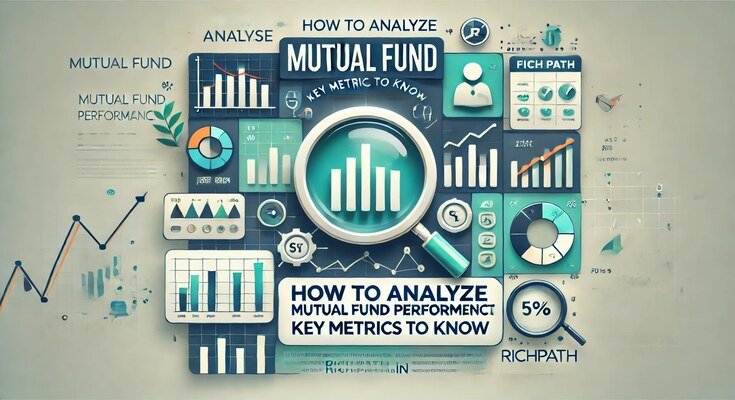How to Analyze Mutual Fund Performance: Key Metrics to Know

Investing in mutual funds is a great way to grow wealth, but selecting the right fund requires careful evaluation. To maximize returns and minimize risks, you must analyze mutual fund performance based on key financial metrics. Understanding these metrics will help you make informed investment decisions and align your portfolio with your financial goals.
This article explores the essential factors to analyze mutual fund performance, provides practical Indian examples, and offers expert tips for making better investment choices.
Why Should You Analyze Mutual Fund Performance?
When you analyze mutual fund performance, you gain insights into:
- Returns: Evaluating past performance to set realistic expectations.
- Risk Levels: Determining if the fund’s volatility aligns with your risk tolerance.
- Fund Comparison: Selecting the best fund among similar options.
- Financial Goal Alignment: Ensuring the chosen fund supports your investment objectives.
Key Metrics to Analyze Mutual Fund Performance
1. Fund Returns (Absolute & CAGR)
Absolute Returns: Measure the percentage change in investment value over a specific period.
Example:
If you invest ₹1,00,000 and it grows to ₹1,20,000 in a year, the absolute return is 20%.
CAGR (Compound Annual Growth Rate): Reflects the annualized return over time, providing a more accurate picture of long-term performance.
Example:
An equity mutual fund delivered these returns:
- Year 1: 12%
- Year 2: 8%
- Year 3: 10%
The CAGR would be approximately 9.96%.
How to Use It?
Look for funds with consistent CAGR over 3, 5, and 10 years to gauge long-term stability.
2. Expense Ratio
The expense ratio is the annual fee charged by the mutual fund for managing your investment. A lower expense ratio results in higher net returns.
- Equity Funds: Typically between 1-2%.
- Debt Funds: Lower, around 0.5-1%.
Example:
If a mutual fund returns 10% and has an expense ratio of 2%, your net return is 8%.
3. Risk Metrics
To analyze mutual fund performance, assessing risk is crucial.
Standard Deviation: Measures how much the fund’s returns fluctuate. Higher values indicate greater volatility.
Beta: Shows the fund’s sensitivity to market movements.
- Beta > 1: More volatile than the market.
- Beta < 1: Less volatile.
Sharpe Ratio: Indicates risk-adjusted returns. A higher Sharpe ratio is preferable.
Example:
- Fund A: Sharpe Ratio 1.5 (better risk-adjusted returns).
- Fund B: Sharpe Ratio 0.8.
4. Fund Category & Benchmark Comparison
Each mutual fund has a benchmark index for performance comparison.
- Large-Cap Funds: Nifty 50 or BSE Sensex.
- Mid-Cap Funds: Nifty Midcap 150.
Example:
If a large-cap fund delivers 12% returns while Nifty 50 offers 10%, the fund has outperformed its benchmark.
5. Portfolio Composition
A fund’s portfolio reveals its investment strategy.
- Equity Funds: Check sector allocation (IT, Pharma, Banking).
- Debt Funds: Analyze bond quality (AAA-rated bonds are safer).
Example:
A mutual fund investing heavily in volatile small-cap stocks may have higher return potential but greater risk.
6. Fund Manager’s Track Record
The expertise of a fund manager significantly impacts performance. When you analyze mutual fund performance, consider:
- How long the manager has handled the fund.
- Performance of other funds managed by them.
Example:
A fund managed by an expert like Prashant Jain (formerly of HDFC Mutual Fund) may inspire greater confidence.
7. Assets Under Management (AUM)
AUM reflects total investor funds in a mutual fund.
- Large AUM: Indicates high investor trust but may reduce flexibility.
- Small AUM: Easier to manage but might lack credibility.
Ideal Range: Choose funds with moderate AUM for better performance stability.
8. Performance Consistency
To analyze mutual fund performance, check consistency across different market conditions:
- Bull Market: Can the fund capitalize on growth?
- Bear Market: Can it limit losses?
Example:
Compare a fund’s 2020 COVID-19 crash performance versus its recovery phase.
9. Tax Efficiency
Understanding tax implications is essential when you analyze mutual fund performance.
Equity Funds:
- Long-term Capital Gains (LTCG): 10% tax for gains above ₹1 lakh.
- Short-term Gains: Taxed at 15%.
Debt Funds:
- LTCG: Taxed at 20% with indexation.
- Short-term Gains: Taxed as per the investor’s income slab.
Choose funds based on tax efficiency in your financial planning.
Indian Examples: How to Analyze Mutual Fund Performance
Example 1: SBI Bluechip Fund (Large-Cap Equity Fund)
- CAGR: 11% (5 years).
- Expense Ratio: 1.70%.
- Sharpe Ratio: 0.87.
- AUM: ₹34,000 crore.
Example 2: ICICI Prudential Balanced Advantage Fund (Hybrid Fund)
- CAGR: 10.5% (5 years).
- Expense Ratio: 1.3%.
- Portfolio: Balanced mix of equity and debt.
Example 3: HDFC Short-Term Debt Fund
- CAGR: 6.5% (3 years).
- Expense Ratio: 0.4%.
- Risk Level: Low (invests in AAA-rated bonds).
Practical Tips to Analyze Mutual Fund Performance
✔ Use Online Tools: Platforms like Groww, Zerodha, and Morningstar provide detailed insights.
✔ Set Clear Goals: Select funds that align with your financial objectives.
✔ Avoid Chasing Past Returns: Historical performance does not guarantee future results.
✔ Monitor Investments Annually: Adjust funds based on performance and market trends.
Conclusion
To make informed investment decisions, it is essential to analyze mutual fund performance using key metrics like returns, risk ratios, expense ratios, and portfolio composition. Whether you are a beginner or an experienced investor, understanding these factors will help you select funds that align with your financial goals.
Mutual funds offer diversified and flexible investment opportunities, but careful analysis ensures higher returns and lower risks.
For expert financial insights, visit Rich Path. and start your investment journey today! 🚀
Read more –
Top 5 Mutual Funds for Long-Term Growth in India in 2025
Best Mutual Funds: How to Choose – A Complete Guide
Best Flexi Cap Mutual Funds to Invest in 2025
Disclaimer:
This article is for educational purposes only and does not constitute financial advice. Mutual fund investments are subject to market risks, and past performance may not reflect future outcomes. Readers should consult a certified financial advisor before making investment decisions.








